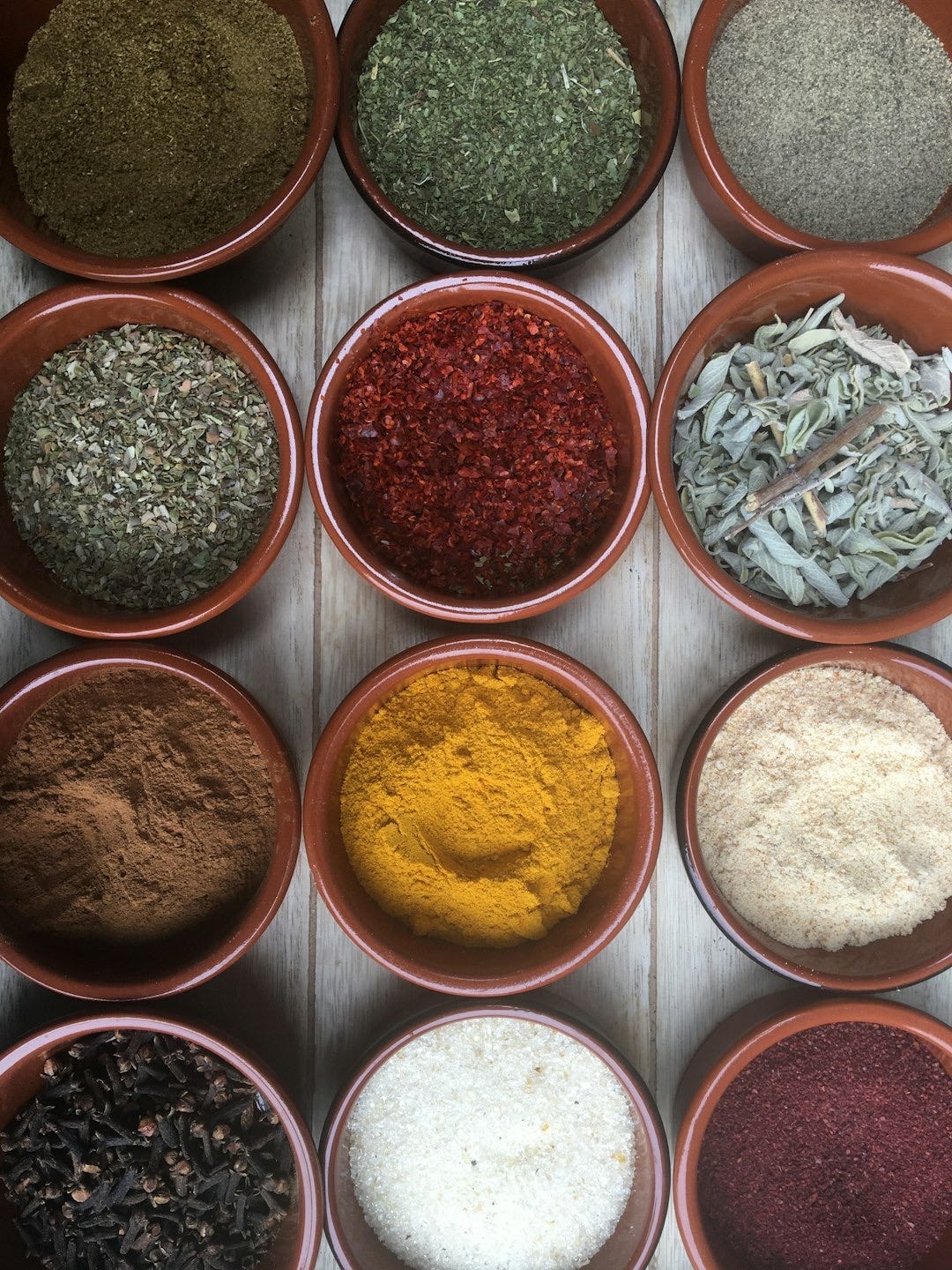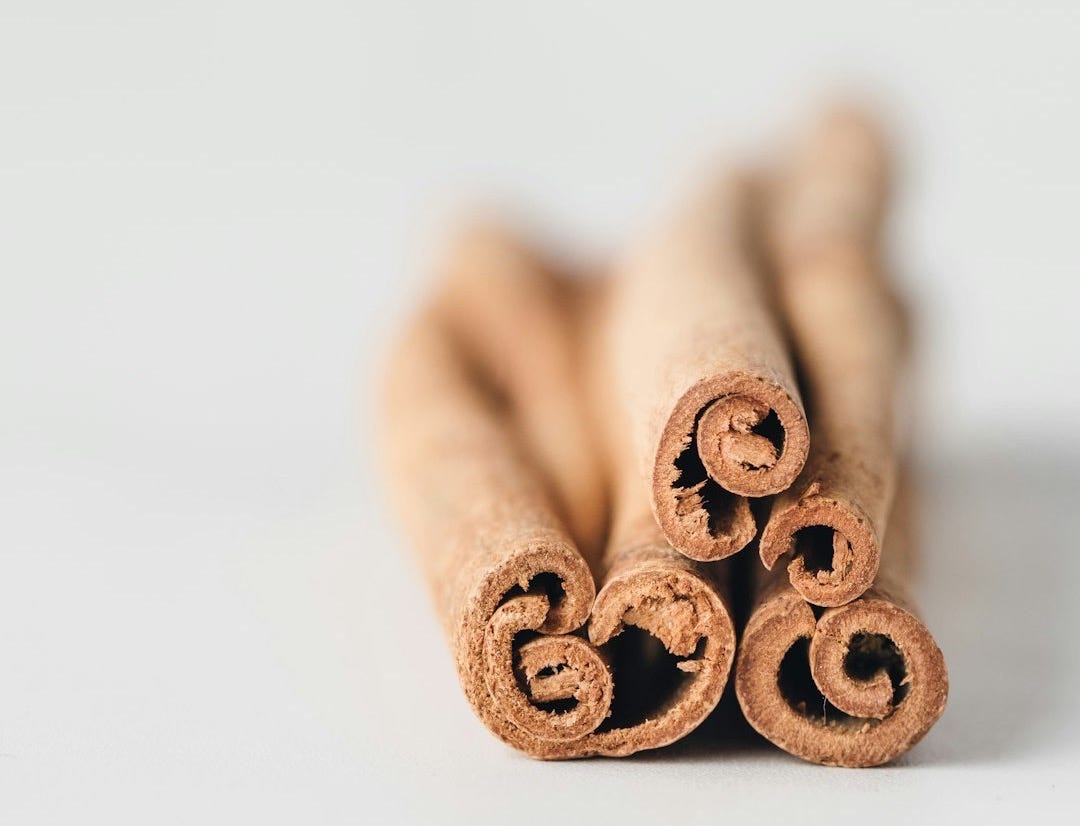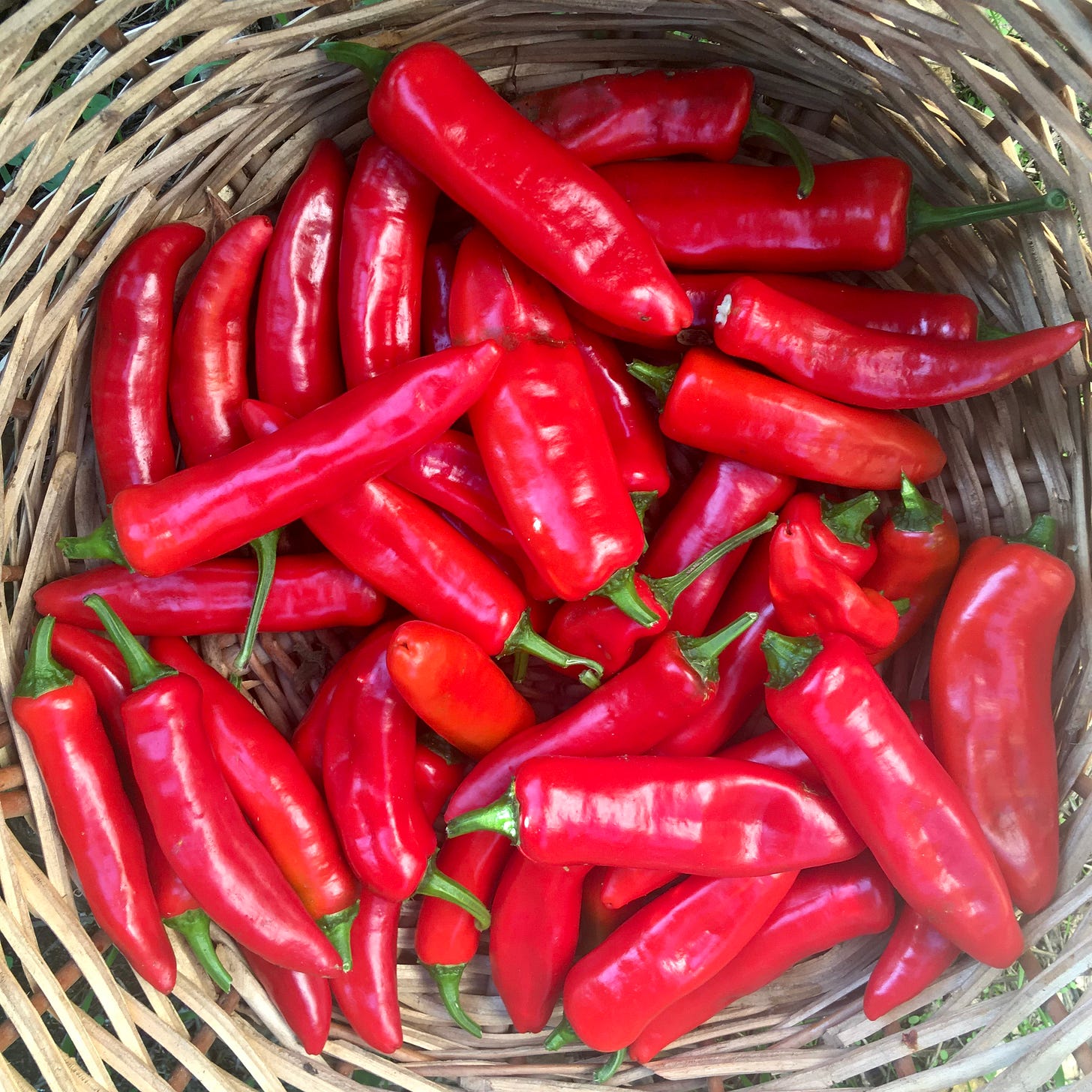Five medicinal plants you didn’t know you had in your kitchen
and how to use them to treat a cold
Hi! This is Marie from Naturally Yours, a newsletter for people seeking simple natural paths to holistic health and emotional balance.
If you want to know more about my philosophy and why I created this space, I invite you to read my very first post.
You can also subscribe to make sure you won’t miss my next articles!
The plants we have at hand
Today, we are going to speak about five medicinal plants we all have in our kitchen and I will explain you how to use them to treat a cold.
Why should we be interested in plants that are so common that they are part of our daily life, you might ask?
Well, because, despite our best efforts, we may not always have a bottle of fire cider, echinacea tincture or elderberry syrup on the shelf.
Sometimes we will get sick just when our favourite herbal remedy has run empty (in fact, that's often precisely when we will get sick). Sometimes we'll be away from home, on holiday, and we won't have our natural pharmacy with us.
What's more, when our friends and family realise that we know about plants, they often start asking us for advice. But how can we help a friend who calls us with a fever at 9pm on a Sunday, or our mother-in-law coming down with flu 300 km away?
By turning to the medicinal plants that we (and our loved ones) always have to hand! They'll be invaluable in an emergency, when we are caught off guard and don't have access to more elaborate preparations.
Plus, although they often seem mundane to us today, the plants we are going to talk about have long been considered powerful remedies. And they are extremely effective when used properly!
Let’s open our cupboards
Let’s open our cupboards and go to meet... *drum rolls*... cinnamon, garlic, onion, ginger and Cayenne pepper! And if you have any doubts about them, I hope that by the end of this article you'll look at them differently.
Since we're in the context of emergency care, I'm going to concentrate on the forms that can be prepared very quickly (because, if you've got the flu, you obviously won't have time to prepare a tincture and wait for it to be ready). I will also share a few more of their handy uses with you.
Ideally, you should start taking those plants as soon as you feel like you're coming down with something! The sooner you act, the better your chances of stopping that cold or that flu before it really starts.
I would love to add that you will achieve much better results with quality plants. We will, of course, prefer organic products.
The doses you will find in the text are adapted to the needs of adults. To give those remedies to children, you will have to adjust the quantities according to their weight.
Please, note that the information given in this article is not a substitute for medical advice. Always use caution and consult a healthcare provider if symptoms persist or worsen. In addition, some plants have contraindications or need to be used respecting certain precautions. Those are listed at the end of this article.
Cinnamon
Cinnamon is one of the most warming plants, and it has the advantage of not being spicy. In addition, it is antibacterial and antiviral.
It will do wonders for you in winter, when you feel you have caught a chill, even if you are not actually ill (yet), or right at the start of a cold or a flu - when your nose starts running with clear or white mucus -, as well as when you have a fever.
Cinnamon is also an excellent ally after an infection, during convalescence. It acts here as a tonic and stimulant, helping you get back on your feet.
But that is not all. Cinnamon is a fantastic plant for your digestive system. It relieves intestinal cramps and has an antidiarrheal effect while being antibacterial, antiviral and antiparasitic. Combine all these properties and you have a valuable remedy for diarrhea and gastroenteritis!
How to use it?
Prefer Ceylon cinnamon (Cinnamomum verum or C. zeylanicum) to Chinese cinnamon (Cinnamomum cassia). This is especially important if you consume large quantities over a long period of time.
You can use it as a powder to make an infusion. For this, steep 2 to 4g per cup for 20 minutes, keeping your tea covered to retain all the aromatic substances.
Cinnamon sticks can be made into a decoction. Bring to the boil for 2 or 3 minutes, then leave to infuse, covered, for 20 minutes.
Drink two to three cups a day.
Dr Valnet gives us a really nice recipe to use from the very first symptoms in order to treat flu-like conditions. For one cup, make a decoction of cinnamon stick with a clove. When it has finished infusing, add half a squeezed lemon and a spoonful of honey, and it's ready to enjoy.
You can also mix cinnamon powder with food (take 3g/day). This is an excellent way to proceed with children, who appreciate its pleasant, sweet taste. You could, for example, add cinnamon to some hot applesauce and serve it to your kids as soon as their noses start running.
That one detail that makes the difference
When we do an infusion, powdered cinnamon allows for better extraction than cinnamon sticks. However, some delicate constituents will oxidize once it is reduced to powder. So, if you buy cinnamon that has been ground for some time, it won't be as effective as it could be.
The optimum? If you can, buy cinnamon sticks and grind them in a coffee grinder right before use.
Garlic
Antiviral and bactericidal, garlic is one of the most effective plants against pathogens.
It is so powerful that it was used by the British army to treat its soldiers during World War I. Later, during World War II, Russian soldiers used it to cope with penicillin shortage.
This is very significant. In wartime, people couldn't afford to rely on remedies that didn't work!
So, we know garlic is a great anti-infective. And it tends to have a concentrated action on the lungs and the respiratory system. But that's not all. It also stimulates the immune system, liquefies mucus production and helps with its expectoration!
It will provide you with extraordinary support for all viral and bacterial winter infections: wet cough, colds, flu, but also pneumonia, bronchitis, tuberculosis, sinusitis…
Plus, being a fantastic tonic, garlic nourishes and strengthens our entire organism, helping us to regain our vitality after an illness.
Of all the plants in your cupboards, if you were to only choose one, it should be garlic!
How to use it?
To benefit from garlic's anti-infective properties, you need to eat it raw! I know, its flavor is strong. But I promise you, it will be worth it!
Eat two to three garlic cloves a day. You can mix it with a little honey, olive oil, apple cider vinegar or tahini to mitigate the taste.
Michel Dubray teaches us that “a medium-sized garlic clove contains 100,000 units of penicillin. To achieve the equivalent of oral penicillin administration, which should be between 600,000 and 1.5 million units depending on the infection, you would need to consume 6 to 12 cloves of garlic per day.”
Such doses would most certainly be irritating to your digestive system, but it's still interesting to know. And it gives us a sense of scale. Considering the potency of penicillin, we can very well see how three cloves of garlic per day will already have a highly significant effect.
That one detail that makes the difference
For maximum effectiveness, you should grate or crush your fresh garlic and let it sit for 15 minutes before consuming it.
Why? Because the main components responsible for garlic's therapeutic effects are not present as such in an intact garlic clove! First, the cell walls of the garlic must be broken by grating or crushing it to allow the alliin and allinase to mix, forming the famous allicin. The allicin is then transformed into diallyl sulphide and disulphide when exposed to air.
To make the most of your garlic, you must ensure that this reaction occurs. Fascinating, isn’t it?
Onion
Onions are antibacterial and will help you eliminate mucus from your airways. It’s an excellent choice when a cold or flu is accompanied by a congestion in the respiratory system (wet cough, blocked nose).
How to use it?
You can use any type of onion (white, yellow, red). They are all great. And they have the advantage of being relatively easy to consume, especially in syrup form!
The preparation couldn’t be easier. Chop an onion finely and place it in a bowl, alternating layers of onion and layers of sugar (prefer unrefined sugar). Cover and leave to macerate for 12 to 24 hours. The sugar will absorb the onion juice and you will quickly obtain, without any cooking, the precious liquid. Filter. It is ready to use!
The sugar can by replaced by a good quality organic honey. This will allow you to benefit simultaneously from the medicinal properties of both onion and honey.
Store your syrup in the fridge. And take 5 tablespoonfuls per day (this means 1 spoon about every 2 hours).
At home, as soon as my son seems to start coughing, I immediately begin to prepare this syrup! I let it macerate overnight, so that I can give it to him first thing in the morning. And I make sure to make enough for a few days.
To clear a blocked nose, you can also cut an onion in half and leave it on your bedside table while you sleep. It is surprisingly effective!
A word about honey
Generally speaking, honey isn’t a very good solvent. Its extraction capacity is relatively low. So, while it gives us pleasant-tasting preparations that are always a nice bonus when we have a cold, it is not the best form to fully benefit from the properties of our medicinal plants. Onion syrup, which is very potent, is an exception here.
Ginger
Ginger is an excellent warming plant, and it is fantastic when we feel we've caught a chill.
Like cinnamon and garlic, it possess several interesting properties in the event of a cold or flu. It stimulates the immune system. It is antiviral. And it helps to liquefy and expectorate thick mucus, which is particularly useful when you have a wet cough.
However, it's not in the respiratory system but in the digestive system that ginger truly excels!
It is one of the most effective plants for calming nausea and stopping vomiting. It soothes intestinal cramps and pain. It is antibacterial and antiviral. And it is traditionally considered an anti-poison remedy.
We have here an ideal combination of properties for gastroenteritis or food poisoning! And ginger proves, indeed, to be invaluable in these situations.
How to use it?
We will take ginger as an infusion. To prepare it, steep 1/2 teaspoon of powder (for 5 to 10 minutes) or 1 teaspoon of freshly grated ginger (for 15 to 20 minutes) per cup. Keep covered. Drink three cups per day
Ginger and cinnamon combine particularly well for both colds and flu, as well as for gastroenteritis.
And if you suffer from nausea or vomiting so intense that you can't drink an infusion, simply cut a slice of ginger and keep it in your mouth. This will help calm the nausea, allowing you to drink your herbal tea.
That one detail that makes the difference
Dried ginger is warmer than fresh ginger. It is therefore more effective in case of winter sickness (provided you have quality ginger, not a powder that was ground a long time ago and has lost most of its properties).
That said, if you don’t have access to quality dried ginger, fresh ginger is still very beneficial. But you'll have to grate it to obtain the best infusion!
Cayenne pepper
Cayenne pepper is a powerful peripheral vasodilator. When you have been in the cold for too long, feel completely frozen getting home and have difficulties warming up, it will help you by sending blood and heat back to your hands and feet.
It is one of the warmest plants.
You can use it when you have a fever, during the phase when you are feeling very cold, shivering and just dreaming of burying yourself under a mountain of blankets. Cayenne pepper will then help you start sweating, supporting the natural fever process.
Cinnamon and ginger, which are also warming and peripheral vasodilators, could be used that way as well, but they are not as effective.
Cayenne pepper will also liquefy mucus and bring movement where it is so thick that it seems completely blocked, helping you to clear your airways. This is, of course, useful when you suffer from a cold, bronchitis or sinusitis and have a productive cough and a congested nose.
Another interesting property of Cayenne pepper is its ability to stop bleeding. Apply Cayenne powder to a cut or a wound, and it will stop the bleeding in just a few seconds! Furthermore, it is also antiseptic and cicatrising. This means that it will help prevent infection and heal the wound. Here is something worth knowing!
How to use it?
Use dried Cayenne powder. Start with small doses to see how well you tolerate it. Then adjust the amounts to achieve a warming effect that still feels comfortable.
If you catch a chill, you can add a pinch to your infusions or, why not, to a hot chocolate (it’s delicious!).
At the onset of the flu, a good ginger tea with Cayenne powder (0.25g to 1g), lemon, and honey will do wonders. You can also mix a small teaspoon of powder in a shot glass of water and drink it in one go.
Then, get into bed and cover up to sweat it out. If you do this in time, you can often break the flu and prevent it from starting.
Let’s sum it up
Let’s sum it up! If you've caught a chill and want to warm up, you can turn to cinnamon, ginger and cayenne pepper. And if (like me) you tend to always feel cold, you can take them on a regular basis throughout the winter.
If you're suffering from a respiratory infection with a productive cough... garlic, garlic, and more garlic! Garlic is your best friend, truly! Onion syrup and ginger will be helpful, but it's garlic that will provide you with the greatest benefits.
Cayenne pepper and onion will help you relieve a blocked nose.
If you've got a fever, are shivering and need to reach the sweating phase, Cayenne pepper is your best choice.
And, during convalescence, garlic and cinnamon will help you regain your vitality.
Finally, for children, cinnamon and onion syrup will undoubtedly be your best allies (I don't know if you've ever tried getting a child to eat raw garlic, but if, by some miracle, you've succeeded, it probably won't happen again!).
And, of course, you can combine all the plants we've been talking about! You can eat three garlic cloves a day while drinking ginger and cinnamon tea and taking onion syrup. That’s definetly how I would do it.
Cinnamon, garlic, onion, ginger and Cayenne pepper will also provide you many benefits when integrated into your diet, both during illness and preventively during the cold season. But don't forget to add them to your dishes only after cooking to fully enjoy their gifts!
What about you? What is your relationship with the medicinal plants you have in your kitchen? Do you use them often in cooking? As medicine? Which one do you prefer? And what is your favorite recipe in case of cold?
Precautions
Here are the main precautions to follow regarding the plants presented in this article. These apply, of course, only when used in therapeutic doses, and not in a culinary context.
That being said, if you are on medication or if you have any doubts, I encourage you to consult your doctor or your pharmacist.
Cinnamon
Cinnamon is contraindicated in therapeutic doses during pregnancy and breastfeeding. It is also not recommended if you suffer from gastric ulcer.
Cinnamon may interact with certain medications, particularly those used to treat diabetes and anti-Vitamin K anticoagulants. If you're on one of these medications, consult your doctor before using cinnamon therapeutically.
Garlic
Raw garlic can be irritating to the digestive mucous membrane. Adjust the dosage according to your sensitivity and avoid it if you suffer from stomach inflammation or acid reflux.
Garlic can have a mild anticoagulant effect. People on blood-thinning medications should use it with caution and consult their doctor before consumming it in therapeutic doses. It is also recommended to stop using garlic in large amounts at least seven days before surgery.
Garlic may have a hypoglycemic effect. Exercise caution if you suffer from diabetes.
Garlic gives a strong taste to breast milk and can be associated with colic in infants.
Ginger
Ginger is contraindicated in cases of gallstones. It can also have a slight anticoagulant effect. If you are taking blood-thinning medication, consult your doctor before consuming it in large amounts.
Cayenne pepper
Cayenne pepper can cause gastrointestinal irritation in sensitive individuals (especially children). Be cautious if you suffer from digestive ulcers. It can also alter the metabolism of certain medications.
I hope you enjoyed this article and found it useful! If you did, please let me know by tapping the 💚 button or by sharing it with a friend!
Thank you!










